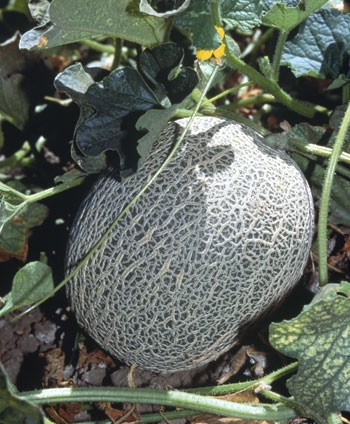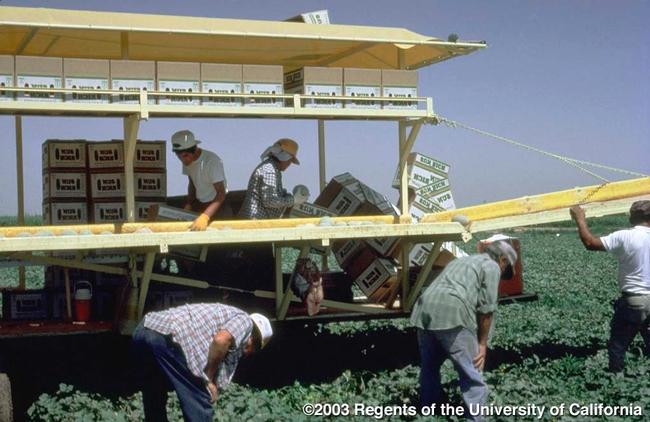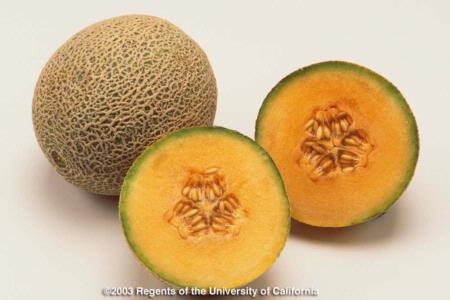Posts Tagged: Cantaloupe
Survey identifies 19 produce candidates for a farm-to-WIC program
A new federal voucher that gives low-income women access to a range of fruits and vegetables could provide unique new marketing opportunities for California growers.
In 2009, the federal Special Supplemental Nutrition Program for Women, Infants and Children (WIC) began distributing monthly cash vouchers to low-income women with children to buy fruits and vegetables. The program reaches almost half of the infants and one-quarter of children under 5 years old in the United States.
A team of UC Cooperative Extension (UCCE) researchers and nutrition advisors has been exploring the possibility of developing a farm-to-WIC program that would link these low-income consumers with local growers. The purpose of such a program would be to increase the consumption of a wide variety of fresh produce, with a focus on locally grown produce when available.
UCCE conducted a survey of produce preferences and buying habits among WIC participants in Tulare, Alameda and Riverside counties in 2010. The full study is published in the January-March 2012 issue of California Agriculture journal.
Based on the results, the UCCE team developed a list of 19 produce items to promote in a possible new farm-to-WIC program. They are:
|
|
|
Although mustard greens and collards were not popular across all sites, the advisors gauged a potential market in Alameda County, so these were retained. Based on write-in responses, oranges were also added.
In California, which has the nation's largest WIC program, 82 local agencies serve about 1.43 million participants at 623 local centers, and WIC participants can redeem their monthly vouchers at 4,000 grocery stores statewide. About 40 percent shop at WIC-only stores, which stock and sell only WIC-authorized foods.
Stocking produce is relatively new to WIC-only stores; before rollout of new WIC food packages in October 2009, these stores were only required to stock limited amounts of fresh carrots. In the survey, most WIC participants (58 percent to 72.3 percent) responded that their preferred stores offered many choices, but fewer participants (18.5 percent to 41 percent) rated the produce quality as “excellent.” Key factors determining purchase decisions were produce quality and freshness, and nutrient value (vitamins and minerals). Cost was relatively less important, possibly because WIC participants procure the produce with the vouchers.
The list has served as a starting point for discussions with growers and WIC vendors.
“The survey showed that WIC participants were interested in purchasing fresh produce with better quality and more variety,” wrote lead author Lucia L. Kaiser, Cooperative Extension specialist in the UC Davis Department of Nutrition, and co-authors, in California Agriculture. “Some WIC participants that we surveyed said they avoided shopping at WIC-only stores in part because these interests were not met.”

A dish made with nopales (cactus pads).
Colorado cantaloupe listeria outbreak affects California growers
The Colorado farm linked to a deadly listeria outbreak last fall is 1,300 miles away, but the tragedy changed a way of life in Mendota, Calif., the Central Valley farm town that proudly calls itself the Cantaloupe Center of the World, said an article in the Los Angeles Times by Diana Marcum.
This would normally be the season when farmers plan the summer crop that in good years is valued at nearly $200 million, according to the California Cantaloupe Advisory Board. Instead, they are cutting acreage and scrambling for ways to reassure a nervous public that cantaloupes are safe to eat.
This month the UC Center for Produce Safety will host a closed-door symposium in San Diego for cantaloupe growers, shippers, agricultural researchers, government regulators and others to create guidelines for best growing practices.
"The main question will be, 'What are the gaps in our knowledge?'" said Bonnie Fernandez-Fenaroli, executive director of the UC Davis-based center. "Do we need to do research or is it a matter of the cantaloupe industry implementing and enforcing best practices?"
UCCE director in Tulare County takes Kings County reins
Lewis Griswald, Fresno Bee News Blog
Tulare County UC Cooperative Extension Director Jim Sullins will also be director of the Kings County UCCE office. Longtime Kings County UCCE director and 4-H youth advisor Peggy Gregory retired at the end of the year. She served 37 years with the University, including 20 in Kings County.
Grape growers fend off thieves, pests
Fresno Business Journal
Pests and thieves can cost grape growers a great deal of money and headaches. That’s why the two issues were addressed along with other important topics at the UC Cooperative Extension San Joaquin Valley Grape Symposium held Wednesday in Easton.
UCCE viticulture farm advisor Stephen Vasquez gave an update on glassy-winged sharpshooters and Pierce's disease. He said that recent catches of sharpshooters are concerning since they have been found near a major riparian corridor that has had a historically low level of Pierce’s disease.
Food safety specialist addresses cantaloupe guidelines
Trevor Suslow, UC Cooperative Extension food safety specialist at Davis, was told by the farm owner that they believed the postharvest system used in conjunction with the outbreak was an improvement over their previous methods — though Suslow disagrees. He acknowledges, however, that the FDA does not make a definitive statement in its growing guidelines on the safest method of cleaning, cooling or packing cantaloupe.
Agricultural program helps keep youth out of gangs
An Associated Press article by Gosia Wozniacka profiles volunteer work by Manuel Jimenez, UC Cooperative Extension farm advisor in Tulare County. The article was published by news outlets such as the Fresno Bee, San Francisco Chronicle, ABC News, Fox News, CBS News, Seattle Post-Intelligencer and others.
He and wife Olga teach life skills and farming techniques to youth on a 14-acre garden in Woodlake, Calif.
"We want to grow kids in our gardens, because we've seen what violence, drugs and alcohol can do," Jimenez told the reporter.
The article also includes comments from youth volunteers in the program, past and present.
"Everything Manuel did was interesting to me," said Walter Martinez, who is now a UC Cooperative Extension field assistant and also served as a volunteer at the garden through middle and high school.
Cantaloupe's rough skin can hide microbes
In a New York Times story about the listeria outbreak linked to cantaloupes grown in Colorado, Trevor Suslow, a Cooperative Extension specialist at UC Davis, explained how bacteria can adhere to the melon's rough skin. Reporter William Neuman quotes Suslow as saying, “You have these tremendous hiding places, if you will, nooks and crannies, lots of areas for microbes to get in and attach and hide.”



